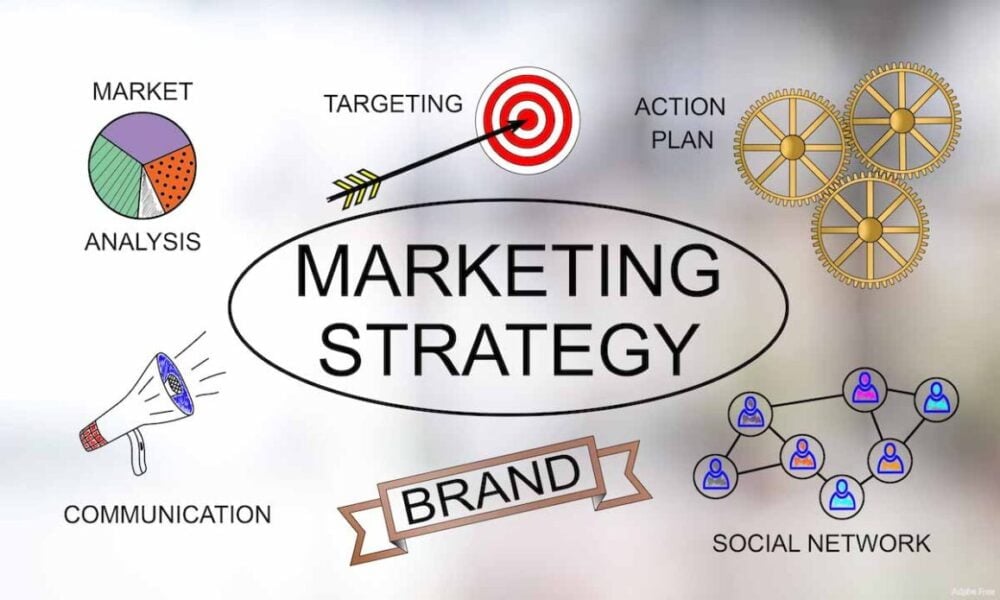Marketing
Signs You Need To Change Your Marketing Strategy

Do you have a ‘set it and forget it’ attitude to marketing? It’s better than no marketing, and what’s not to love about automation and ‘set and forget’ campaigns? Unfortunately, your audience may not agree with you. Marketing is fast-paced and constantly evolving. If you haven’t changed your marketing strategy for a while, it’s time you did.
Once you have developed a great product or service, the next thing that will make or break your business is your marketing strategy. People can’t purchase a product they’ve never heard of, and they won’t buy from you if the marketing messages you send out turn them off.
If you’ve taken to recurring campaigns and your business has been doing the same thing for a long time, then you could certainly benefit from assessing your strategy and making some tweaks. If you’re not sure whether it’s essential, in this article, we have a few clear-cut signs that your marketing strategy needs a shake-up, including:
- Repetition – using the same strategy for years
- Not meeting your KPIs
- Your offerings have changed
- You no longer know your audience
- You don’t have a story
Let’s work through our 13 signs. You need to change your marketing strategy to avoid your business failing!
1. Using The Same Marketing Strategy
Many companies adopt an attitude of if it’s not broken, don’t fix it, and if sales are steady, it can be very tempting to just do more of the same. Regular sales after years of using the same marketing strategy, however, may be a sign of some seriously unfulfilled potential.
Your customers obviously still like your product. Maybe you get some new business from word-of-mouth or your existing marketing channels. However, a shake-up in how you implement your marketing could attract a whole new section of potential customers to the business.
New audiences
Depending on your product or service and how long it has been on the market, an entirely new generation of customers may have come of age since you last switched up your marketing strategy. Gen Z now has over $140bn in spending power, but your current marketing strategies may not be reaching them. If it has been a while since you adjusted your plan, there are certainly some potential customers you’re not reaching.
2. What KPIs?
You’re not meeting your KPIs, or you’re not even sure what they are.
Whatever your key performance indicators (KPIs) are, are you meeting them? Are you bringing in the number of sales, leads, or subscriptions you need to? If not, tweaking your marketing can help. Maybe you’re not even sure of the answer to this one. Perhaps you’re not even sure what your KPIs are. In that case, you need to get some clarity.
Digital marketing needs goals and measurement
Part of modern-day digital marketing strategies generally involve setting clear objectives and specific metrics to measure. In a world where software can easily track clicks, engagement, conversions, sales, and the exact number of seconds potential customers spend on each page of your website, there’s no excuse to not set clear objectives that can be easily measured. Those measurements inform plans for future marketing activities.
3. Your Offerings Have Changed
If you’ve launched new products and services, they may not be suited to your old marketing channels. The more visual your offerings, the more you want to explore channels that are a mainly visual experience.
Go for the visual experience
Products that need a demonstration clearly lend themselves to video-sharing platforms, such as Instagram and TikTok. Even if you know that Facebook, for example, is the best channel to reach your particular audience, new products may mean that it’s time to employ more Facebook Lives, reels, and video ads.
New product launches offer an excellent opportunity to step up your marketing, but don’t assume that more of what has worked in the past is right for a brand-new line or product. Before starting a new marketing campaign, you need to determine which channels and strategies will allow you to show off your new offerings to the best effect.
4. Your Audience Has Changed
If the target market for your new offering is different, or there are potential buyers of your old products out there that you’re not reaching, you need to think about how you can successfully get all your target demographic groups.
Who is your audience?
Those valuable Gen Z buyers we’ve already mentioned are nothing like their parents or grandparents. They spend a lot more time on TikTok and don’t check their email too often, and many of them prefer automation and self-service rather than having to deal with a real human being.
What’s more, Gen Z doesn’t trust larger institutions but does trust their favorite influencers. They deliberately tweak their own algorithms by engaging with the content they want to see more of, and they like brands to take a stance on important social and environmental issues. Who your target market is, impacts much more on your marketing success than the platforms you use to reach them. Knowing your audience will determine everything that follows, including:
- Which customer service technology to use
- The content of your marketing messages
- Who your business supports i.e. charities
- Marketing collaborations
5. You’re Attracting The Wrong Audience
Sometimes the people who engage with your marketing content simply aren’t actually your potential customers. If you have engagement but no real return on investment (ROI), you need to consider why. Maybe the content you’re sharing appeals to a group with no real interest in the product. Or perhaps something is off with how you’re targeting your paid promotions.
Better alignment of incentives
Suppose you are getting lots of leads but few conversions. In that case, it could be that the free incentive you offer to get people onto your list simply isn’t well aligned with your paid offerings, or the sequence of emails you’re sending out isn’t leading people towards your paid offerings or selling the benefits of them well enough.
There are a few different areas to look out for if engagement is high, but sales are low, and all of them can indicate that a change is needed in your overall strategy.
6. You Don’t Have A Story
Modern-day consumers love a story. Sure, they care about the features and benefits of your products. However, in a competitive world, with so many brands competing for attention, the story can be what sets you apart. What is your brand’s story? How did it come to be? How did the founders meet? What was their light-bulb moment? What sets you apart? And why does what you do matter in the great scheme of things?
What’s your brand’s story?
The story of a brand or company doesn’t have to be long or complicated, but it does have to be compelling. And it has to be consistent. Wherever a member of your audience comes across you online or in the real world, they expect you to behave in a way that aligns with what they expect of you based on what they know about your story.
St. Bonaventure University demonstrates this in its piece looking at what makes a successful marketing campaign. Examining 10 of the best campaigns of all time, it concludes that at the heart of each successful marketing campaign is the concept of the story – sometimes a straightforward one, but always one that the brand’s audience understands and can relate to.
7. Your Website Isn’t Working For You
We’re not talking about slow loading speeds, broken links, or outdated information, though all of this should be corrected. If you haven’t revamped your website for a while, with your marketing objectives in mind, you may find that your customer journey is just not happening the way that you want it to when potential customers land on your website.
Customer journey
Your analytics should give you a good idea of what people are or aren’t, doing when they get to your website. Are they browsing? Buying? Signing up for your email list? Consuming your content? Or simply clicking away?
Your website should take your customers and potential customers on a journey that introduces them to your brand, showcases your products, get them engaged with what you have to offer, and ultimately results in sales. If it’s not doing any of that, it’s time for an overhaul.
Take a good look at the content pulling people to your website and how it’s getting them there. Are they landing there as a result of search queries, paid ads, or social shares? Are they coming to read the content on your blog or take advantage of a special offer or promotion? The key to more and happier customers is in your website analytic reports. You just have to look for it.
Site not optimized for mobile
Even within older and more traditional demographic groups, mobile phone usage and mobile internet browsing are high. Many of those in younger groups access the internet almost exclusively via mobile. A poorly optimized site for mobile is a potential hindrance to attracting new interest, leads, and sales.
It’s vital to ensure that the customer journey is as easy on a phone as on a computer and that your overall marketing strategy and your website (including sales pages) are fully compatible with mobile devices. Visitors who have problems accessing what they need on their mobile won’t necessarily switch to another device. It’s generally much easier to switch to a different website or company that sells something similar.
8. Your Marketing Budget Has Changed
The amount of money you have to spend on marketing activities can dictate what your strategy will be. More money in the budget means opportunities to try new and innovative strategies to attract new customers and maybe take a few more risks. If, on the other hand, your budget is now tighter than it has been in the past, that’s not a disaster. It is, however, a sign that you need to change your strategy to fit your budget.
Test unusual marketing initiatives
Cheaper tactics will need to be employed, which is not always bad. Different approaches work for different products, so more affordable doesn’t always mean less effective. You may find that your ROI even improves when you try more unusual marketing techniques that cost less money. A budget reduction can be an opportunity to rethink things and adopt more efficient tactics, rather than the other obvious solution, which is to just do less of what you’re already doing.
9. Your Social Pages Are Dead
Your social media pages may not be actually dead, just inactive. Purchase decisions are often made on, or influenced by, social media. Social media is also where many potential customers will be exposed to your brand for the first time and where some customers develop an affinity with the brand that will later influence purchasing decisions. That first contact doesn’t have to be direct exposure to your product. It could just as quickly be a meme or quote shared by your page or a link to an article that potential customers will find interesting.
More social less promotion
While social media marketing is an important part of overall marketing strategy, for most companies, it should still be more social than sales-speak. The more people engage with the content you share, whether directly related to your products or not, the more visible your social accounts become.
If your social media channels are dead, it’s time to switch up the kind of content you share to get them thriving again. This is best planned as part of your overall marketing strategy as this will help keep those overriding messages and your brand personality consistent.
10. The Online Buzz Is About Your Competitors
The last thing you want to be doing is blindly copying competitors. Each marketing campaign should be unique, but if you see a lot of buzz online about your competitors and you’re getting lost in the crowd, it’s probably time to tweak your marketing strategy.
Copycat tactics
Take a look at what those competitors are doing. You don’t want to do the same, but you want to see what’s working for them and what’s not. Competitors’ campaigns can show you a lot about what people expect from this type of brand, what kind of content they engage with most, on which platforms, and what they care about when making a purchase decision.
11. Your Customers Are Not Happy
Listening to what your customers say is one of the most underrated ways to improve your strategy and increase your sales. If customers are confused, sending you questions, and looking for clarity, that’s an excellent opportunity to take a close look at your messaging and make it more transparent.
Use customer feedback
Customer complaints are a free well of ideas for improvements, especially when it comes to specific things such as how customers prefer to communicate with you. Again, this might have changed since you last assessed your marketing activities. People used to like to pick up the phone and talk to a human being. Now, many prefer to resolve things online. Many customers used to hate dealing with chatbots and other automated systems. Now, many expect them and see them as efficient.
12. Your ROI On Paid Promotions Is Low
PPC ads can be a great way to reach new people, generate new leads, and see sales quickly. However, PPC is easy to get wrong, and it can be costly. Whether you run ads on social sites or elsewhere, PPC marketing can fail to produce a good ROI because your targeting is off.
Are your Ads relevant?
Whether you are running Google ads or social ads, you need to target the right people and display content that’s genuinely relevant to them, especially, for example, if you are going for paid search results.
Retargeting ads effectively is another excellent way to put your offers in front of the people who have already expressed interest in them – but again, this needs to be done carefully and strategically. If you are not seeing a significant ROI from paid promotion, then it’s probably time to reassess that whole area of your strategy and look at ways to reduce expenditure and target more effectively.
13. Your Organic Traffic Is Low
Organic traffic from search results is always valuable, as long as the content you provide is relevant and linked to your paid offerings. If you haven’t changed your strategy in a while, then you can expect organic traffic to drop off.
To attract organic traffic, you need SEO, and what constitutes ‘good SEO’ changes over time. Changes in search algorithms can easily cause your website, or individual pages, to drop rankings. Even small changes and updates to how Google and other search engines classify and rank content can have a significant impact.
SEO
If you rely on organic traffic, then changes in SEO need to be constantly monitored to ensure that your most important pages are still ranking and delivering relevant content strongly linked to user intent. A lot of high-quality content that perfectly markets what you have to offer is only good if your target market is actually getting to see it.
Final Words
Ultimately, developing a strong marketing strategy should be ongoing and responsive. The best strategies evolve when a firm monitors all of its marketing activities and stays agile, responding quickly to issues and changes that impact the company and its brands. If you’ve decided it’s time to switch up your marketing strategy, that’s great. Just remember to put in place systems to monitor, analyze and develop that strategy over time.









